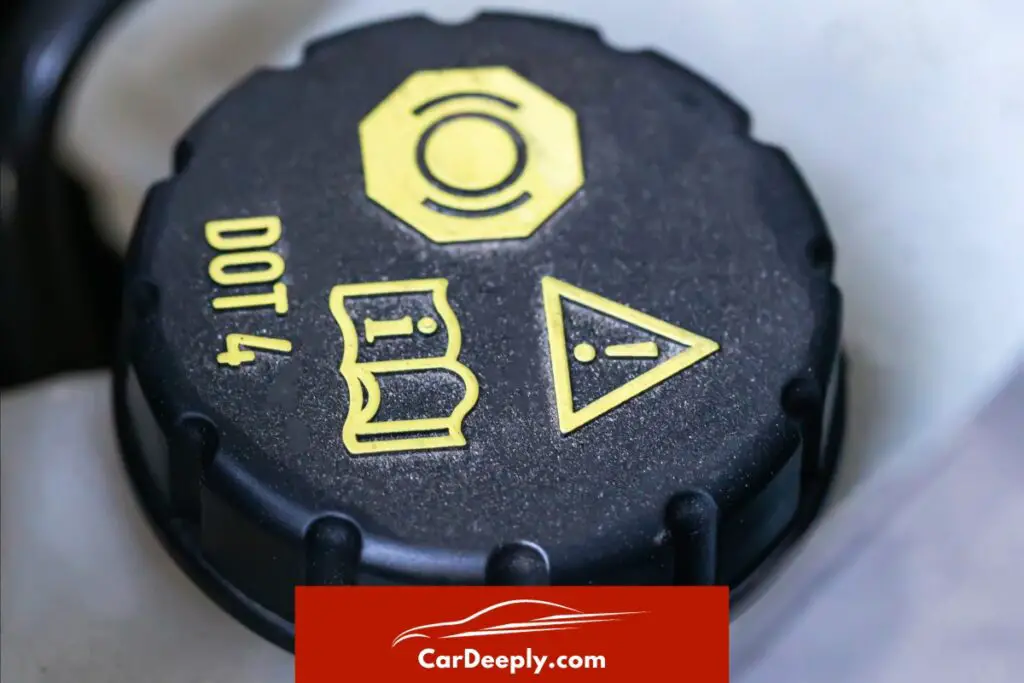Choosing the correct type of brake fluid for your Ford F150 is not just a matter of maintenance; it’s a matter of safety. That’s why we’ve compiled this comprehensive guide to help you make an informed decision.
- Learn the science behind brake fluid types and their compatibility.
- Discover the step-by-step process for safely replacing brake fluid.
- Uncover expert tips for maintaining optimal brake performance.
Don’t risk your safety or waste money on unnecessary repairs. Dive in to find out exactly how to choose and maintain the brake fluid perfect for your Ford F150.
Key Takeaways

- Brake fluid is crucial for safety and affects braking power and component lifespan.
- Use Motorcraft® DOT 4 LV fluid that meets the WSS-M6C65-A2 specification.
- Replace brake fluid every 3 years to maintain optimal performance.
- A step-by-step guide can help you replace brake fluid yourself.
- Avoid common mistakes like using the wrong fluid type and ignoring the 3-year rule.
Why Brake Fluid Matters for Your Ford F-150
Understanding the significance of brake fluid in your Ford F150 goes beyond mere vehicle maintenance; it’s a critical factor impacting your road safety.
Brake fluid serves as the lifeblood of your brake system, transmitting the force you apply on the brake pedal to the brake components. Let’s delve into why this is so crucial.
The Role of Brake Fluid in Braking Power
Brake fluid transfers the mechanical force you exert on the brake pedal to the brake calipers, which clamp down on the brake discs.
This process is what brings your vehicle to a halt. Using the wrong type of brake fluid can result in poor brake performance, putting you and others at risk.
- Tip: Always check the brake fluid level in the master cylinder and top it up with the recommended type, usually Motorcraft® DOT 4 Low Viscosity (LV) High-Performance Motor Vehicle Brake Fluid.
Extending Component Lifespan
The right brake fluid also plays a role in extending the lifespan of your brake system components. Corrosion is a common issue in brake systems, and using a fluid that doesn’t meet the specifications can accelerate this process.
- Note: The recommended specification for the Ford F150 is WSS-M6C65-A2. Using a fluid that meets this specification can extend the life of your brake components by up to 3 years.
Types of Brake Fluid: What Ford Recommends
Regarding your Ford F150, the manufacturer recommends Motorcraft® DOT 4 Low Viscosity (LV) High Performance Motor Vehicle Brake Fluid. This specific fluid meets the WSS-M6C65-A2 specification, ensuring optimal performance and longevity of your brake system components.
- How to Check: Look for the specification number WSS-M6C65-A2 on the brake fluid container. If it’s not there, don’t use it.
When to Replace Brake Fluid in Your Ford F-150
Ford recommends replacing the brake fluid in your F150 every 3 years. This 3-year interval is crucial for maintaining optimal brake performance and component lifespan.
If you want to keep your metal pet happy for a long time and if you want to have only the best in your F150, you have to check out which brake pads are the best!
- Reminder: Mark your calendar or set a reminder on your phone to check and possibly replace your brake fluid every 3 years.
Step-by-Step Guide to Replacing Brake Fluid
Replacing the brake fluid in your Ford F150 is a task you can accomplish with the right tools and guidance. Here’s how:
- Gather Tools: You’ll need a brake bleeder kit, a wrench, and a clear tube.
- Locate the Brake Reservoir: Usually found near the master cylinder.
- Empty Old Fluid: Use a turkey baster to remove as much old fluid as possible.
- Add New Fluid: Fill the reservoir with the recommended Motorcraft® DOT 4 LV fluid.
- Bleed the Brakes: Attach the bleeder kit to the brake bleeder valve and pump until you see no air bubbles.
Common Mistakes to Avoid
Lastly, let’s address some common pitfalls:
- Wrong Fluid Type: Always use the recommended Motorcraft® DOT 4 LV fluid to avoid compromising your brake system.
- Ignoring the 3-Year Rule: Failing to replace the brake fluid every 3 years can lead to corrosion and reduced performance.
By adhering to these guidelines, you’re ensuring a smooth ride and safeguarding your life and those of others on the road.
Conclusion: Your Roadmap to Brake Fluid Excellence
You’ve made it to the end of this comprehensive guide, and by now, you should be well-equipped with the knowledge and practical tips to manage the brake fluid in your Ford F150 effectively. But before you go, let’s summarize the key takeaways.
Summing Up the Essentials
- Brake Fluid’s Role: It’s not just a liquid in a reservoir; it’s the linchpin of your brake system, affecting both safety and component longevity.
- The Right Choice: Motorcraft® DOT 4 Low Viscosity (LV) High-Performance Motor Vehicle Brake Fluid is the go-to option, meeting the WSS-M6C65-A2 specification.
- Timely Replacement: Every 3 years is the magic number. Stick to it to avoid unnecessary risks and expenses.
Your Next Steps: A Call to Action
Armed with this information, you’re ready to take action. Here’s what you should consider doing next:
- Check Your Brake Fluid: Now is the time if you haven’t done so recently. Use a flashlight to inspect the brake fluid level in the master cylinder.
- Schedule a Replacement: If it’s been close to or over 3 years, schedule a brake fluid replacement. You can do it yourself following our step-by-step guide or take your Ford F150 to a trusted mechanic.
- Spread the Word: Knowledge is power, but it’s even more powerful when shared. Consider sharing this guide with other Ford F150 owners you know.
By adhering to these guidelines and taking proactive steps, you’re not just ensuring a smooth and safe ride but also extending the lifespan of your vehicle’s brake components.
So why wait? Please take action today and give your Ford F150 the care it deserves.
Frequently Asked Questions
Can I Mix Different Types of Brake Fluids in My Ford F150?
No, mixing different types of brake fluids is not recommended. Always stick to the Motorcraft® DOT 4 Low Viscosity (LV) High-Performance Motor Vehicle Brake Fluid that meets the WSS-M6C65-A2 specification for optimal brake performance and component longevity.
How Do I Know if My Brake Fluid is Contaminated?
Signs of contaminated brake fluid include a spongy brake pedal, decreased braking power, and visible particles. If you notice these symptoms, it’s time for a brake fluid replacement.
What Happens if I Skip the 3-Year Replacement Interval?
Skipping the 3-year replacement interval can lead to corrosion in the brake system and reduced braking performance. It’s crucial to adhere to this timeline to maintain optimal brake system health.
Can I Perform a Brake Fluid Replacement Myself?
Yes, you can perform a brake fluid replacement with the right tools and guidance. You’ll need a brake bleeder kit, a wrench, and a clear tube. Follow the step-by-step guide provided for a successful replacement.
Is There a Way to Extend the Lifespan of My Brake Fluid?
While there’s no guaranteed way to extend the lifespan of brake fluid, regular checks and using the recommended Motorcraft® DOT 4 LV fluid can help maintain its quality and performance.

Luna Meschiari is a full-blooded car nut who is well known to local garages, as each article is meticulously researched and peppered with the latest piece of information. Guess what car she’s driving right now? A RAV4 2021 Hybrid. But her heart also sleeps for pickups like the F-150. Get to know Luna better on the about us page.
Advertising links are marked with *. We receive a small commission on sales, nothing changes for you.
